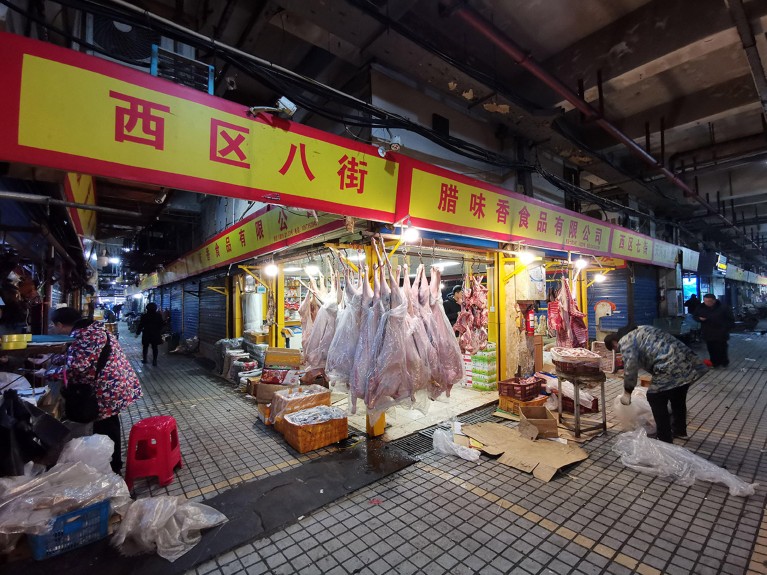First peer-reviewed analysis of the Chinese swabs confirms animal DNA was present in samples that tested positive for SARS-CoV-2.

Researchers at the Chinese Center for Disease Control and Prevention (China CDC) have published an eagerly awaited analysis1 of swabs collected at a wet market in Wuhan, China, in the early weeks of the COVID-19 pandemic — as well as the underlying data, which the international research community has been calling for since the beginning of the outbreak.
The analysis, published in Nature on 5 April, confirms that swabs from the Huanan Seafood Wholesale Market — which closed in January 2020 and has long been linked to the start of the pandemic — contained genetic material from wild animals and tested positive for SARS-CoV-2. This suggests that it’s possible an animal could have been an intermediate host of a virus that spilled over to infect humans. But researchers say the latest findings still fall short of providing definitive proof that SARS-CoV-2 originated from an animal-to-human spillover event. (The study authors, led by former China CDC director George Gao, did not respond to requests for comment from Nature’s news team, which is editorially independent of Nature’s journal team.)COVID-origins report sparks debate over major genome hub GISAID
Still, researchers say that the publication of the genomic data, which have been deposited on open repositories, is crucial — because it will allow further analyses that could offer clues about the pandemic’s origin. “It’s one of the most important data sets we’ve had since the emergence of the pandemic,” says Florence Débarre, an evolutionary biologist at the French national research agency CNRS in Paris, who was part of a team that caused controversy by publishing its own analysis of the China CDC data last month. “They exist because at the time the right things were done.”
Evolutionary virologist Jesse Bloom says that although the swabs, which were collected in January 2020, provide useful information about what animals were at the market, even earlier samples are needed to find the pandemic’s origins. “If we ever learn the exact origins of SARS-CoV-2, I suspect it will come from new information about cases or events in early December or November of 2019, or earlier,” says Bloom, who is at the Fred Hutchinson Cancer Center in Seattle, Washington.
The paper is the latest in a series of published analyses of these market samples, and the first to be peer reviewed. The findings agree with a separate preprint analysis that the swabs contain genetic data from wild animals and from SARS-CoV-2. But these environmental samples do not confirm that any of the animals present were infected with the virus.
The Chinese team behind the latest report had published a preprint version2 of its study in February 2022 that did not include an analysis of animal genetic material in the swabs, and did not make public the underlying sequence data. The team that included Débarre found the China CDC swab data in the online genomics database GISAID and published its own analysis on the research repository Zenodo3. That report identified wild-animal material in the swabs that tested positive for SARS-CoV-2 and pointed to animals, including raccoon dogs, as species of interest.
Contentious study
The latest report lends weight to one of the two competing theories about how the COVID-19 pandemic began. Debate has raged over whether it had a natural origin, with a virus passing from animals to humans, or arose from a laboratory leak at the Wuhan Institute of Virology.
The Huanan market has been at the centre of the natural-origin theory because several of the earliest known cases of COVID-19 were linked to the market. Animals that were sold there are known to be hosts for respiratory viruses called sarbecoviruses, which include SARS-CoV-2. However, the lab-leak hypothesis gained momentum in 2021 and has not been definitively ruled out.

The latest paper, like the Zenodo report, contains details about mammalian genomic sequences present in the market samples. The authors analysed 60 samples that tested positive for SARS-CoV-2 — 11 more than in the Zenodo report — and a further 112 swabs that were negative.
The findings support the natural-origin hypothesis, says a researcher who was not involved in either study and wishes to remain anonymous owing to the controversy surrounding COVID-origins work. The presence of many wild-animal species means that a viral spillover that resulted in the COVID-19 pandemic could have occurred, says the scientist. Some of those species, such as raccoon dogs, have the potential to transmit SARS-CoV-2 infections, the source adds. “The extent of circumstantial evidence [in the latest paper] is greater than one can find for the alternate hypothesis, which is that it leaked from a laboratory.”COVID-origins study links raccoon dogs to Wuhan market: what scientists think
The study also offers clues about the role of the market in the pandemic’s origin. In the early weeks of the outbreak, two lineages of SARS-CoV-2 — dubbed A and B — were circulating. Initially, tests identified only lineage B at the market. This led some researchers to conclude that the market might have acted only as a site for an early ‘superspreader’ event, rather than as a site of an animal spillover, because lineage A is thought to be more ancestral.
But the China CDC’s preprint posted last year identified lineage A in one sample. “It’s the result that really made me shift, that made me really say, ‘OK, it’s very likely to come from the market,’” says Débarre. But she says that some questioned whether the result was real. The new analysis confirms the presence of lineage A, addressing those doubts, she says.
David Relman, a microbiologist at Stanford University in California, agrees with the authors’ assessment in the study that the market might have acted as an amplifier of SARS-CoV-2 transmission. “It’s just as possible that humans brought the virus into the market, as animals might have.”
Spurious findings
Alice Hughes, a conservation biologist at the University of Hong Kong, has concerns about the quality of the analysis. As well as genomic fragments from animals including raccoon dogs, Hughes says that the paper identifies genetic material from pandas, mole rats and chimpanzees. Given that killing a panda attracts the death sentence in China, “there is absolutely no way any trace of panda could possibly be in that market”, she says.
The strange results could be from laboratory contamination, or improper processing of the data that failed to weed out spurious species identifications, says Hughes. “We must be exceedingly careful with interpreting or putting too much faith in the paper.”
Débarre also questions aspects of the results. The China CDC authors used two genomic-analysis methods: one that searches through all available genes and genomes, and another that zeroes in on specific sequences in the mitochondrial genome. The whole-genome method detected only a few raccoon-dog sequences in a sample that was full of raccoon-dog nucleic acids, according to the Zenodo analysis and the China CDC’s mitochondrial genome analysis, says Débarre.
The data do not clearly point to a specific animal as an intermediate host that passed the virus onto humans. But the researcher who wished to remain anonymous says that the results again highlight some animals, including raccoon dogs, that can be studied for how well they transmit SARS-CoV-2.
Débarre says that further forensic analyses could reveal whether any animal DNA in the swabs bears signs of immune-system activation, which could indicate active infection. That could help to address concerns that the presence of virus and animal DNA in the same sample does not necessarily indicate that an animal was infected.
But Relman doesn’t think that further analyses of the same data set could lead to significant answers about the virus’s origin. “What we really need are other kinds of data. Good verifiable data on the early clinical events in Wuhan.”
source: Nature
